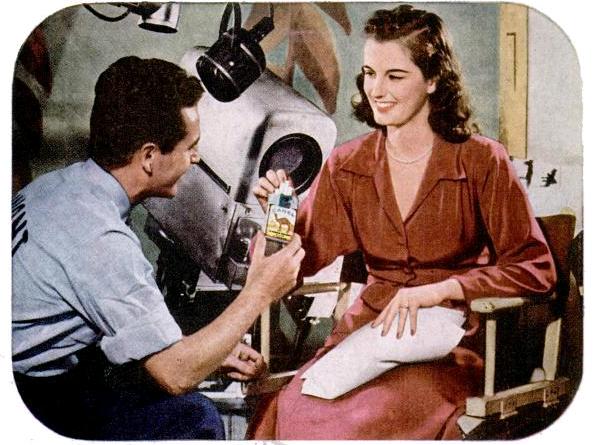Seventy years ago today, life was good. The War was over, television was becoming a reality, and you could buy a pack of Camels whenever you wanted. Shown here in the December 10, 1945, issue of Life Magazine is Loretta A. Brophy, getting ready to enjoy a Camel during a break from her busy job as program director at the New York DuMont television station, WABD.
The ad also showed Miss Brophy rehearsing with a song-and-dance team, but pointed out that the next day, it might be a quiz program or grand opera. Miss Brophy called her job “fast, exciting, fun!”
And when she called “cut,” that meant the show was over, but Camels were still in order. She reported that during the wartime cigarette shortage, “when I couldn’t get Camels, I smoked anything I could get, more different brands than I can remember. That’s when I learned really to appreciate Camels–there’s nothing like a Camel.”
Other than this advertisement, I wasn’t able to find any other references to Miss Brophy, although she was obviously one of the pioneers of television. She wasn’t alone, as women held a number of important positions.
 While not mentioning Miss Brophy, the Spring 1945 issue of Televiser carried a feature entitled “Women in Television.” At WABD, when the wartime manpower crisis put a damper on hiring, “women in slacks blossomed forth as ‘cable engineers’ (studioese for people who haul co-axial cables out of the way of the cameramen). One of WABD’s early staffers was Dotty Wooten, shown here. She was hired as a stenographer in 1943, but was one day called in to fill an emergency slot as announcer. The magazine reported that she had filled the announcing post ever since.
While not mentioning Miss Brophy, the Spring 1945 issue of Televiser carried a feature entitled “Women in Television.” At WABD, when the wartime manpower crisis put a damper on hiring, “women in slacks blossomed forth as ‘cable engineers’ (studioese for people who haul co-axial cables out of the way of the cameramen). One of WABD’s early staffers was Dotty Wooten, shown here. She was hired as a stenographer in 1943, but was one day called in to fill an emergency slot as announcer. The magazine reported that she had filled the announcing post ever since.
In our previous post about WABD, we noted that the station really had no full-time staff when it first came on the air. The station was on the air three evenings a week, and was largely staffed by workers at DuMont’s New Jersey war plant. With men off to war, it wasn’t surprising that women were called on to staff the station.
The same issue of Televiser gave some insight into the challenges faced by Miss Brophy in her job. Directing a television program was challenging, as it involved careful choreography of the cameras. Each of the large cameras was fed with a thick coaxial cable from behind. Therefore (except perhaps with the assistance of one those cable engineers), it was impossible for one camera to cross behind another. Therefore, one camera had to be already in place for the next shot before the second camera “dollied in” for a closeup. Interestingly, the byline for the sidebar explaining this choreography was that of a woman, one Patricia Murray, also on the staff of WABD.
Click Here For Today’s Ripley’s Believe It Or Not Cartoon
![]()

